Inside the Gates Foundation
Simply sign up to the Life & Arts myFT Digest -- delivered directly to your inbox.
The Bill & Melinda Gates Foundation is the richest private foundation in the world. It has ambitions to save millions of lives, to eradicate killer diseases and to wage war on poverty and hunger. Yet for an organisation that is sitting on an endowment of $36.4bn, it presents a modest face to the public.
Next year the foundation plans to move into its own purpose-built campus in Seattle. But, for the moment, it is scattered around a series of nondescript office buildings in the city. My series of meetings at the foundation last month began at 1260 Mercer, a low-rise, low-key office building situated on the slopes of Seattle, just above the Pacific Ocean. There is nothing on the outside of the building to identify this as the Bill & Melinda Gates Foundation, and the lobby is a bit like a dentist’s waiting room: a few magazines scattered around; a television with the sound down. The only other person waiting is another Brit – a professor from Nottingham, who is hoping to pitch a new educational testing programme to the foundation.
Once inside the portals, the Gates Foundation feels like a cross between a United Nations agency and a high-tech start up. In true Silicon Valley style, nobody ever wears a tie and the staff is cheerily multinational. Yet rather than being computer geeks, the foundation’s people are more likely to be medics, or experts on seed technology – and to have last worked in government, or agricultural research, or a teaching hospital, rather than in the corporate world.
The promotional material and PowerPoint presentations shown to visitors have all the bright professionalism of a sales graph for a Microsoft product. But here the graphs will typically illustrate the foundation’s progress in reducing infant mortality around the world rather than success in shifting the latest version of Microsoft Office.
The office walls of Sylvia Mathews Burwell, the president of the foundation’s global development programme and a White House veteran, feature a poster of a small African child sitting in a washing-up bowl, who Burwell refers to as “the boss”. In fact, the real boss is – of course – Bill Gates, the founder of Microsoft.
Day to day, the foundation is run by Jeff Raikes, another Microsoft veteran, whose years at the software giant made him rich enough to put $100m of his money into his own family foundation, the Raikes Foundation, which focuses on the problems of adolescence. Raikes is a cheerful Nebraskan, with the habit of beginning each answer with an encouraging “That’s a really great question.”
He remembers that when he moved over from Microsoft, everybody warned him he was entering a very different world. The foundation would be full of touchy-feely types and there would be no market forces with which to gauge success or failure. But the basic job, as he sees it, is rather similar – managing a large organisation that is growing rapidly, setting priorities, demanding evidence and numbers to back up hunches, developing new ideas that will change the world. “Microsoft is all about intellectual property,” he says, “and so is the Gates Foundation.” At the foundation, the staff is working away on everything from finding a vaccine for HIV to discovering drought-resistant strains of rice.
The Gates Foundation was started in 1994. The really big bequests were made in 2000 by Gates, and have since been supplemented by further billions from his friend and bridge partner, the billionaire investor Warren Buffett.
In just a decade, Gates has created the world’s largest private foundation. But it would be a mistake to believe that he is waging a lone struggle. The topics that the foundation has chosen to work on – global health, global development and education in the US – already receive a great deal of money and intellectual attention. Giant institutions such as the World Bank, the World Health Organisation and the UN Development Programme, as well as big national aid donors, university departments and private charities all over the world, are working on similar problems.
So what is it that Gates and his wife, Melinda, who is also a driving force behind the foundation and, increasingly, its public face, can bring to the party? The foundation has looked carefully for areas that it believes have been neglected by other players. It has poured cash into the search for vaccines not only for HIV but for malaria, and is engaged in a big push finally to eradicate the polio virus. It also presciently decided to devote a lot of money to agricultural research, just a couple of years before the global food crisis broke out.
In that sense, the foundation is behaving like a business, looking for neglected niches in the market. But, perhaps above all, the Gates Foundation reflects the founder’s restless intellectual energy – and his determination to bring the optimistic vision, drive and flair for technology that created Microsoft into entirely new areas.
While many charitable ventures and government departments proceed slowly and bureaucratically, the foundation is run like a venture-capital fund. Gates and his team are looking for risky ventures to back, convinced that it is worth taking a “high risk, high return” approach to crack some of the worst problems in global health and development. Buffett has said of the foundation, “If we succeed all the time, we’re failing” – the foundation is not taking enough risks.
The foundation’s approach is epitomised by its work on HIV and Aids. Stefano Bertozzi, the director of the HIV programme, says that the Gates Foundation deliberately funds the sort of cutting-edge and experimental approaches that might not get funding from official bodies that are using taxpayers’ money. Jeff Raikes says that the foundation’s efforts to develop a microbicide spray that women can use to inhibit the spread of HIV might fail, but “Even if it fails, we can learn from the failure and build on it.” As he points out, a typical venture-capitalist in Silicon Valley might back 10 ventures. “The majority will fail, but you should hit one home run, as well.”
Not everybody is enthused by the Gates approach. Some argue that the founder’s background in technology means that he is too transfixed by the search for technological “magic bullets” to fix health problems, when often the problems involved are social or developmental: persuading Nigerian clerics to let children have the polio vaccine, persuading South African men to protect themselves better against HIV by getting circumcised. In fact, the foundation is involved in both efforts, as it has built up a development programme alongside the health programme.
But there is still a feeling, even within the foundation itself, that development is a slightly unloved second child compared to the high-tech health programmes that enthuse Gates himself. Certainly, when Gates talks in an unscripted way about the foundation and its priorities it is clear that his imagination is most caught by health issues and, in particular, the search for new cures and vaccines. In Seattle he told me that, while it was agreed that the foundation would devote some of its resources to a crucial issue, US education, others would be allocated elsewhere. “We decided the rest would go for whatever the toughest problem is outside. And we picked global health as the primary thing. We do some things around health balance and health development. But … the biggest piece of it is health and helping the poorest.”
Melinda Gates, Bill’s wife and the co-chair of the foundation, is particularly closely involved with the development programme, however. In some ways, she has become the softer public face of the foundation: lobbying tirelessly at the UN to promote its goals and travelling frequently in the developing world. Although the foundation’s staff is naturally reluctant to dwell on any difference in emphasis between the two heads of the organisation, there is a sense that Melinda has made the development side of the business her own. She has backed a drive to reduce infant mortality in India, for example, by encouraging mothers to start feeding their newborn babies earlier [in some rural areas mother and baby are initially separated].
The extent to which the foundation is a reflection of its founders’ personal interests and passions leads to another critique. The Lancet, the British medical journal, has suggested that some of the foundation’s priorities are a bit “whimsical”, driven as they are by the reading, interests and hunches of the polymath that is Bill Gates.
That criticism, too, is rejected by the foundation, albeit politely – and with earnest expressions of their eagerness to learn from such criticism. The phrase you hear more often than any other, if you wander the corridors of its offices, is “evidence-based”. Gates himself says: “We have very clear criteria of what we fund in global health – having to do with what other people don’t fund, what the burden of disease is and what the scientific choice is. So it’s all quite numerical.”
Still, there is no doubt that the foundation has Gates’s stamp all over it. One of the upshots of his entrepreneurial approach is the foundation’s Grand Challenges Fund, where people with bright ideas for research can apply for seed-capital of up to $1m on a single, two-sided form.
At times, Gates’s intellectual presence at the foundation is vaguely reminiscent of Willy Wonka, the factory owner in Roald Dahl’s book Charlie and the Chocolate Factory. Wonka is constantly coming up with amazing new sweets – but even he might have been surprised by the development of a chewing gum that can detect the malaria virus in saliva, which has been produced as part of the Grand Challenges in Global Health fund. In another scheme, Indian researchers are developing a hand-held “electronic nose” that analyses breath samples to diagnose tuberculosis.
Gates says that one of the things that links his first career, as the builder of Microsoft, and his new life as a philanthropist, is the pleasure he takes in hiring “super-smart people” and unleashing them on some of the world’s most complicated technical challenges. At a time when official development budgets are being cut all over the western world, the Gates Foundation is becoming a haven for both people and projects.
The foundation cannot yet point to a single, signature breakthrough that will forever be associated with its name in the way that the Green Revolution in agriculture will always be linked to the Rockefeller Foundation. So far it has spent $4.5bn on vaccine research, but the “magic bullet” for HIV or malaria is yet to be found. It is early days, of course. Gates explains that much of the scientific research that the foundation is funding may take more than a decade to pay off – and it has committed a further $10bn to basic vaccine research. Even now, however, the foundation can (and does) claim to have saved the lives of millions of children simply by increasing the numbers who have been given existing vaccines against killer diseases.
At a troubled time for the US and the western world, it is difficult to leave the Gates Foundation’s offices without feeling a little more positive. It exemplifies a very west-coast blend of optimism about the future, internationalism, and belief in technological progress.
Yet I left Seattle wondering whether the foundation also represents a last hurrah for a world that is now passing. In the old world, ideas, money and expertise flowed from the western world into the developing world. Over the next decades, as Bill Gates himself would happily acknowledge, much of the dynamism is likely to come from the other side of the Pacific Ocean.
Gideon Rachman is the FT’s international affairs editor
…………………………………………..
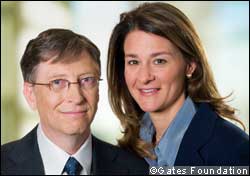
Bill Gates
Co-chair and trustee
Education: Harvard University (he left before graduating but received an honorary law degree in 2007)
Previous posts: Chief software architect and chairman of Microsoft, a company he founded with childhood friend Paul Allen
Goals: To combat extreme poverty and poor health in developing countries and to improve the US education system
Grants given in 2009: $3bn
Achievements: The Gates Foundation has given out $24bn in grants since 1994 – $3bn into global development, $14bn into global health and $6bn into improving US education
…
Melinda French Gates
Co-chair and trustee
Education: Duke University
Previous posts: General manager of Information Products at Microsoft
Goals: To combat extreme poverty and poor health in developing countries and to improve the US education system
Grants given in 2009: $3bn
Achievements: The Gates Foundation has an asset trust endowment of $36.4bn and 874 employees working in offices in Seattle, Washington DC, New Delhi, Beijing and London. The grants support work in over 100 countries worldwide and all 50 states of the US
…………………………………………..
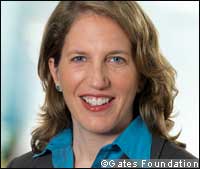
Sylvia Mathews Burwell
President, Global Development Program
Education: Harvard University, Oxford University
Previous posts: Deputy chief of staff to President Clinton; chief of staff to Treasury secretary Robert E. Rubin
Goals: To increase opportunities in the developing world for people to lift themselves out of hunger and poverty
Gates grants in 2009: $677m
Achievements: More than $1.4bn given to small farmers to help boost their productivity since 2006. Other grants range from $100m to help create the Alliance for a Green Revolution in Africa (Agra) to $10m to provide computers with internet access in Chilean public libraries
“History has shown that almost no country has managed a rapid rise from poverty without increasing its agricultural development,” argues Sylvia Mathews Burwell. The former Washington high-flyer is a passionate believer in the importance of such progress. As well as providing new technologies in this area, her programme at the Gates Foundation is also trying to foster new markets for farmers. A typical project involves working with Coca-Cola to encourage the multinational to buy more fruit from local farmers in Kenya and Uganda.
…………………………………………..
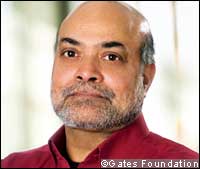
Prabhu Pingali
Deputy director, Agricultural Development, Policy and Statistics
Education: Birla Institute; North Carolina State University; Stanford University
Previous posts: Director at the UNFAO; economist, World Bank
Goals: To help 150 million of the world’s poorest farming families
Gates grants in 2009: $316m
Achievements: $164.5m to Agra’s soil programme
Prior to moving to the Gates Foundation, Prabhu Pingali had spent decades working in agricultural development around the world. But he noticed something new when he arrived in Seattle. “Here we can actually make a difference because we can put money behind our ideas. At the UN we hardly had money to do anything other than publish papers,” he says.
Pingali believes that the world needs a “second green revolution”. It was the first Green Revolution that dramatically raised agricultural yields in poor countries and helped to alleviate famine. But now, the development of India, China and other emerging powers – combined with climate change – is leading to rising food prices. Pingali believes that unless we can increase agricultural productivity and improve distribution again, acute hunger will once more be on the rise.
Even so, the foundation only represents about 4 per cent of total global spending on agricultural development, so it has to pick and choose its targets. Cutting-edge research is a top priority, as is the effort to encourage farmers to try new techniques and strains of crop – and that can involve simple things like sponsoring radio talk-shows for farmers in Kenya. One of the programmes that the foundation is particularly enthusiastic about is the drive to sponsor the adoption of a new drought-tolerant strain of maize that will help African farmers cope with the ever-more-frequent “extreme weather events” that are disrupting agriculture.
…………………………………………..
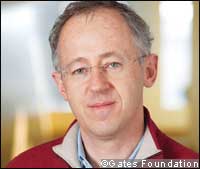
Stefano Bertozzi
Director, HIV and Tuberculosis, Global Health Program
Education: MIT; UC San Diego; UC San Francisco
Previous Posts: Director of the WHO Global Programme on Aids; Chair of the UNAids Economic Reference Group
Goals: To stop the spread of HIV and prevent 14 million TB deaths by 2015
Gates grants in 2009: HIV/Aids: $222m; tuberculosis: $122m
Achievements: More than $2.2bn committed to HIV grants worldwide and $750m towards combating TB
Stefano Bertozzi is increasingly hopeful about the chances of developing an Aids vaccine. A doctor and economist, who has been working on Aids and HIV since the mid-1980s, he observes: “We’ve been depressed for many years because people have taken lots of shots on goal that have missed, but over the last year we’ve had much more positive signals.” These include recent results of an HIV vaccine trial in Thailand, which for the first time suggested that an experimental vaccine was reducing the numbers of new infections.
Bertozzi joined the Gates Foundation last year after many years working in developing countries, and still seems to be suffering from a mild case of culture shock. “The culture here is much more corporate than I expected,” he says, “although I can’t work out whether that’s because of the foundation, or just because I’m living in America again. But that’s mainly a good thing. There is more strategic vision.”
Bertozzi says that it is a misperception to believe that the foundation’s contribution is mainly its huge wealth: “In HIV, we’re relatively small players, next to say the Global Fund for Aids,” he observes. “I don’t feel particularly rich. We torture the budget for efficiencies.” But what the foundation can do is to fund “high risk, high reward” research that might be too much of a long shot to attract public funding. In that sense, the foundation behaves more like a venture-capital fund than a government department – backing bright ideas, in the hope that one or two will pay off in a big way.
…………………………………………..
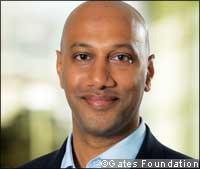
Rajeev Venkayya
Director, Global Health Vaccine Delivery, Global Health Program
Education: Northeastern Ohio Universities College of Medicine
Previous posts: Special assistant and senior director for Biodefense under President George W. Bush
Goals: To prevent 4 million deaths through vaccination each year; to eradicate polio by 2012 and improve efforts to control measles
Gates grants in 2009: $117m
Achievements: $10bn committed over the next decade to develop vaccines for poorest countries; helped to get new vaccines for hepatitis B and HiB into widespread use
As a doctor and former presidential assistant, Rajeev Venkayya is used to hard work. But the Gates Foundation is still a challenge. “This job is in some ways more demanding than the White House,” he muses, “because we have set ourselves very exacting goals. If polio is not eradicated around the world by 2012, we will have failed.”
Finally getting rid of polio, says Venkayya, would “demonstrate to the world the art of the possible. You can wipe an entire disease off the face of the earth. After that, I think we could eradicate measles – 75 per cent of measles cases occur in just one country, India, so it’s eminently doable. And after that, guinea worm. And malaria is the big one. We expect to have a malaria vaccine by 2014.”
While others work on developing new treatments, Venkayya’s focus is on making sure that existing treatments reach their targets. “Really it’s about reaching all the children.” This can mean things as varied as tracking migratory populations and persuading religious leaders in Nigeria not to oppose vaccination. He reckons that it is vital to set expectations and benchmarks to give philanthropic work clear goals: “It’s almost the equivalent of a business’s sales targets.” The foundation works very closely with Gavi, the global alliance for childhood vaccination, which brings together public and private initiatives. “Our role is not to just push money out of the door,” says Venkayya, “we also act as a kind of quality-assurance programme for the work we fund via a laser-like focus on specific investments.”
…………………………………………..
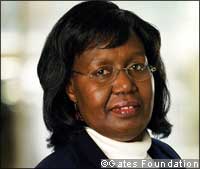
Mercy Karanja
Senior program officer, Agriculture
Education: Nairobi University, Kenya; University of Reading, UK
Previous posts: Assistant director of the Kenya Ministry of Agriculture; development policy co-ordinator of the International Federation of Agricultural Producers
Goals: To help 150 million of the world’s poorest farming families out of poverty by 2025
Gates grants in 2009: $316m
Achievements: The Agriculture programme has also given $42m towards the development of drought-resistant maize “It’s a very unbureaucratic place,” Mercy Karanja says of the foundation. “If I say supporting institutions is important, they say, ‘OK, go and do it.’” The Kenyan national sees her job in the Agriculture programme as “spreading best practice”. This involves getting the message out to farmers across the world about new techniques and products. This could be as simple as sponsoring radio programmes on how best to fence in animals or cultivate tomatoes.
…………………………………………..
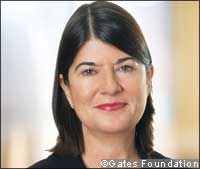
Vicki Phillips
Director of Education, College Ready
Education: Western Kentucky University; University of Lincoln, UK
Previous posts: US Office of Education, superintendent of Portland Public Schools in Oregon; secretary of education for Pennsylvania
Goals: To ensure that 80 per cent of high-school students are ready for college
Gates grants in 2009: $373m (to all US education programmes)
Achievements: $4bn in the past eight years; 2,602 schools opened or improved; 12,000 Gates Millennium Scholarships awarded
For Vicki Phillips, the campaign to get more American children ready to study in college has a strongly personal element. Brought up on a small farm in Kentucky, she was the first member of her family ever to go to university.
The programme to improve US education can look like a bit of an anomaly in the foundation’s portfolio. But there is a philosophical link. The founding principle and motto of the Gates Foundation is the idea that “Every life has equal value”. Yet there are stark inequalities in life chances in the US – many of which have their roots in educational opportunity.
The foundation’s initial emphasis on smaller class sizes did not yield the sharp improvement in qualifications it was looking for, so its new focus is on trying to get “effective teachers into every classroom”. It is funding large-scale programmes in specific school districts that are experimenting with new career ladders for teachers, new types of school, new ways of measuring effective teaching and innovative technologies that can improve teaching.
Additional reporting by Amie Tsang
Comments